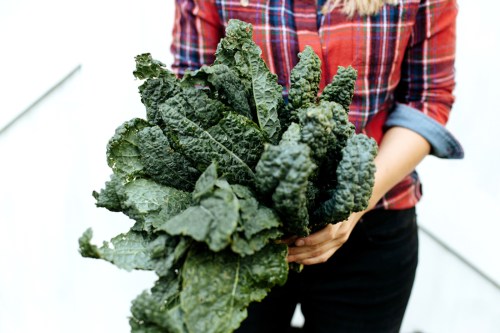6 Healthy Winter Vegetables That Don’t Require a Whole Lot of Space To Grow
Mother's Finest Urban Farms owner Samantha Foxx gives tips on how to grow winter vegetables, listing six that thrive in cold weather.

Maybe it’s because we’re spending a surplus of time at home these days, but it certainly seems like nurturing plants has reached peak popularity during the pandemic. And our plant-purchasing isn’t just for decoration either: In a recent survey of 990 people who had purchased houseplants since March 2020, more than half of the people who bought plants during the pandemic said they purchased them with the intention of growing their own food.
Experts in This Article
Samantha Foxx is an urban farmer, beekeeeper, and the founder of Mother’s Finest Urban Farms, located in Winston-Salem, North Carolina.
Whether it’s growing herbs on your kitchen windowsill, sprouting seeds, or planting a vegetable garden in your backyard, farming your own food in these ways isn’t just cost-effective, it’s rewarding, too. What’s more satisfying than plopping down an entree on the kitchen table and proclaiming, “Not only did I make this, I grew it, too!”
While you might associate growing produce with the spring, fall, and summer, growing winter vegetables is absolutely possible too. Just ask Samantha Foxx, who started Mother’s Finest Urban Farms three years ago as a way to educate and serve her local community in Winston-Salem, North Carolina. Foxx’s farm grows produce year-round. (She also has chickens and is a beekeeper.) If there’s anyone who knows about winter vegetable growing, it’s her.
What Foxx first wants people to know about vegetable growing, no matter what time of year it is, is that you don’t need a whole lot of space to do it. “Our farm is technically an urban farm because we’re on a busy street and we’re really just using a vacant lot in our backyard,” she says. “The key is really to maximize your space and making the most of it. Especially during the pandemic, there’s no better time to do something that offers a little more self-sufficiency and sustainability.” If you do have a lot of space to grow produce, Foxx adds that it’s a wonderful opportunity to use it as a way to serve the community.
Foxx says she starts planning her winter vegetable planting at the end of August or early September—yep, that early. This is primarily because she supplies much of her produce to CSA box subscription members; she says studying data of how much of each veggie to plant is an important part of the planning process. If you’re just playing a few winter vegetables for your household, you don’t need to think so far in advance, but it still does require planning. A good rule of thumb is to start six to eight weeks before you anticipate the first frost.
Need help figuring out what to plant? Below is a list of winter vegetables to consider with Foxx’s tips on how to grow them. Plus, how each veggie will benefit your body.
6 winter plants that can survive a cold climate
1. Greens
According to Foxx, kale, collard greens, and lettuce can all thrive during winter. “They are pretty similar in terms of how to grow them, too,” she says. If you’ve never grown greens before, Foxx recommends starting with kale or collard greens. “Collard greens in particular is one of the most resilient plants I’ve ever encountered,” she says. “It’s so beautiful and can withstand almost anything. My God, I want to have the strength of collard greens.”
When you’re preparing your gardening beds for your winter veggie planting, first remove any dead vegetation, which could have a fungus that could prevent your new plants from growing. The next step is to add a layer of compost (for greens, she likes leaf compost) to protect the soil. “[Compost] also helps lock in the moisture which is especially important since the ground is so cold this time of year,” Foxx says. (She adds hay can be incorporated into compost for winter produce, too.) After laying an inch or two of compost, plant your lettuce seeds. You’ll want to add another layer of compost after the first frost.
Whatever type of greens you decide to grow, your bounty will be full of nutritional benefits. All of them have fiber and antioxidants, but there are certain nutrient qualities that set different types of greens apart from each other. Collard greens are a surprisingly good source of protein, with five grams a cup. Kale has a category of phytochemicals called glucosinolates—a group of compounds that help to support the liver’s natural detoxification processes and other bodily functions. And romaine lettuce contains lactucarium, a plant compound that is associated with sleep.
2. Carrots
Because they grow primarily belowground, carrots are another vegetable that can survive a wide range of climates, including a cold winter chill. “Carrots have the teensiest of seeds. You can put them really lightly in the ground on a raised bed,” Foxx says. She says you can use the same soil and mulch mixture for carrots as your greens—and in fact all the winter vegetables listed here. Also like the greens, the key is to keep the soil moist. Plant the seeds a half-inch apart from each other; carrots don’t need too much room to grow.
Nutritionally, carrots are one of the best veggies for eye health thanks to their high vitamin A content, so if you spend a lot of time staring at a screen, add them to the top of your what-to-plant list. Eating carrots also supports the immune system because they contain vitamin C—definitely something that’s always on everyone’s minds during the winter months.
3. Garlic
“Everyone loves to cook with garlic especially in the colder months, so this is a great vegetable to grow,” Foxx says. Even if you don’t have any yard space at all, she says you can still grow garlic using a container or even a bucket. Just add your soil and mulch (it should be three inches from the top) and drop your garlic cloves in, spaced roughly three inches away from each other. Then, cover the cloves with a couple inches of soil. Place your container or bucket with your growing garlic in a place where it can get a good six hours of sun a day, and water it enough to keep the soil moist.
Though it’s used in just small amounts in most recipes, garlic is packed with nutritional benefits. A run-down of some of the nutrients it boasts vitamin B6, manganese, selenium, vitamin c, iron, potassium, and copper. Like carrots, garlic also contains vitamin C and helps support a healthy immune system.
Watch the video below to learn more about the health benefits of garlic:
4. Brussels sprouts
Remember how Foxx said how collard greens were really durable? She says Brussels sprouts have a dose of that grit too; even snow can’t stop them from thriving. One note about growing Brussels: they take between three to six month for the seeds to mature, so this is one winter vegetable that definitely requires some advance planning. It’s a good idea to start growing them inside in a container and then replanting them outside after about three or four months. When you replant them outside, place them about a foot and a half apart in an area where they’ll get plenty of sunlight. “Brussels sprouts don’t require much maintenance. Just prune the leaves, pulling them back, as it continues to grow,” Foxx says, adding that the healthiest leaves shouldn’t be pulled off because they feed the stalk.
Brussels sprouts are a good source of vitamin C as well as vitamin K, a key nutrient for bone health. “Brussels sprouts also offer support to the balance of bacteria in the digestive tract, while providing a variety of phytochemicals such as sulforaphane, which is researched for its antioxidant properties,” registered dietitian Kelly Jones, RD, previously told Well+Good.
Looking for a delicious way to jazz up your roasted Brussels sprouts? Toss them with this anti-inflammatory salad dressing:
5. Purple broccoli
“There are some really colorful foods that grow during winter too, like purple broccoli,” Foxx says. The hues for this winter veggie range from deep purple to a vibrant magenta. Its hearty texture helps protect it from harsh winter climates, too. This is another vegetable that needs a lot of sunshine to thrive, so plant the seeds in a sunny spot and keep the water moist. Similar to garlic, you can start growing purple broccoli inside in a container and then replant it outside, once it’s about three inches tall.
Fun fact about purple broccoli: it has even more vitamin C and antioxidants than green broccoli. And think about how gorgeous it will look on your plate.
6. Cauliflower
The last veggie on Foxx’s winter vegetable list is cauliflower. Like purple broccoli, she says its hardy texture makes it durable in harsh climates. She explains that cauliflower is grown similarly to purple broccoli, so you can follow the same guidelines.
One big benefit to growing and consuming cauliflower is that it’s good for digestion. “The high fiber content of cauliflower makes it a superstar for digestive health as well,” registered dietitian Maya Feller, RDN, previously told Well+Good. Besides being good for your gut, Feller adds that high-fiber diets have been associated with improved cardiovascular health—specifically, reduced risk of cardiovascular disease and stroke. That means this veggie is good for your heart, too.
When it comes to growing winter vegetables, Foxx says that what’s most important is just the desire to do it; growing them doesn’t take much maintenance or room. Even if you just have one raised bed, a container, or a bucket, you can still grow something. “If you have kids, involve them too!” she encourages. “It’s a fun way to connect them more to the food they eat and to try new things.”
Oh hi! You look like someone who loves free workouts, discounts for cult-fave wellness brands, and exclusive Well+Good content. Sign up for Well+, our online community of wellness insiders, and unlock your rewards instantly.









